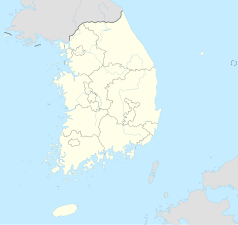Sŭngga sa
| Państwo | |
|---|---|
| Miejscowość |
góra Pukhan, Seul |
| Rodzaj klasztoru | |
| Właściciel | |
| Typ zakonu |
męski |
| Materiał budowlany |
drewno |
| Data budowy | |
| Data zburzenia |
1953 |
| Data reaktywacji |
1955 |
Położenie na mapie Korei Południowej  | |
Sŭngga sa (승가사 Klasztor Sanghi) – koreański klasztor.
Historia klasztoru
[edytuj | edytuj kod]Klasztor został wybudowany w 756 roku na zboczu góry Pukhan. Został tak nazwany po tym, jak mnich Sut'ae zainstalował wyobrażenie mnicha z Indii – mistrza Sŭngga, którego uważano za inkarnację bodhisattwy Awalokiteśwary[1].
Uważa się także, że właśnie w tym klasztorze słynny mistrz sŏn Hamhŏ Tŭkt'ong (znany także jako Kihwa) (1376–1433) osiągnął swoją duchową realizację. Jego imię Hamhŏ, pochodzi od nazwy jego pokoju medytacyjnego i oznacza „Dom Pustki”[2].
Klasztor został opuszczony i prawie całkowicie zniszczony w czasie okupacji japońskiej w latach 1910-1945, a resztę zniszczeń dokonała wojna koreańska (1950–1953). W 1955 roku mnich Towon odbudował zniszczone budynki.
Z czterech górskich klasztorów Seulu – Sŭngga znajduje się na północy, podczas gdy Chingwan na zachodzie, Pulam na wschodzie, Sammak na południu.
Adres klasztoru
[edytuj | edytuj kod]- 4 Gugi-dong (213 Bibong 4-gil), Jongno-gu, Seoul, Korea Południowa
Linki zewnętrzne
[edytuj | edytuj kod]Bibliografia
[edytuj | edytuj kod]- Chris Verebes. Empty House. Zen Masters and Temples of Korea. Eastward Books, Seul, Korea, str. 330 ISBN 89-952155-4-2
Przypisy
[edytuj | edytuj kod]Galeria
[edytuj | edytuj kod]-
Grota
-
Mnich Sŭngga
-
Podobizna mnicha Sŭnggi
Text is available under the CC BY-SA 4.0 license; additional terms may apply.
Images, videos and audio are available under their respective licenses.



